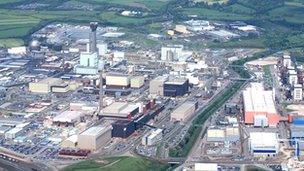Nuclear space batteries could boost Sellafield jobs
- Published

There could be new life in old waste from Sellafield
Up to 50 jobs could be created at Sellafield in the development of nuclear batteries to power spacecraft.
Chemists at Britain's National Nuclear Laboratory (NNL) plan to make the batteries using Sellafield's large store of waste plutonium.
The batteries could then be used as a power supply for the European Space Agency's (Esa) spacecraft.
As well as the new jobs, this project could accrue significant UK multi-million pound exports.
In 2009, Esa funded a pilot project to examine the cost and practicality of establishing a European source of material for Radioactive Power Sources (RPS).
RPSs are ultra-long life batteries for use in the Esa's deep space programme.
The RPS batteries are not to launch the spacecraft, but to keep instruments running over several decades.
Tim Tinsley, programme manager for NNL, said: "We're more than half way through the £1m pilot proving the viability of being able to extract the isotope [chemical element] from the civil plutonium stockpiles.
"We have a quantity of this plutonium at our labs at the Sellafield site and a team of highly experienced chemists are 'proving' the chemical flow-sheet for the process."
Export potential
Currently, Esa uses an isotope called plutonium-238 for these batteries, but this is only available from Russia and America.
It is also only available from military reactors, and supplies could run out in about 2018.
This would mean the isotope being extracted at Sellafield - called americium-241 - could not only be used in Esa's projects, but would also open the door for an even greater multi-million pound export potential to countries currently reliant on plutonium-238.
Mr Tinsley said: "Technically, there are no barriers to the success of the project, it would be down to funding and politics within Europe and they are already tightly constrained.
"Esa needs this fuel source for their space 'road-map' - they cannot do it without it and we at NNL are doing everything we can to make that a success."
But deep space exploration is only one use for the isotope that is being explored.
"There'll always be domestic applications that require a power source for a 20 or 30-year duration in inaccessible locations such as deep sea or deep underground in oil wells," added Mr Tinsley.
In November, Esa will decide whether or not to continue the funding.
If funding is ratified, Mr Tinsley suggests that jobs could start being created steadily from 2014 to a point of full production around 2020.
- Published13 February 2012